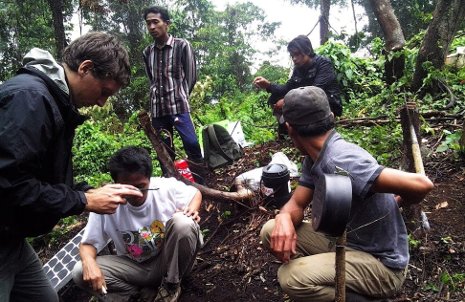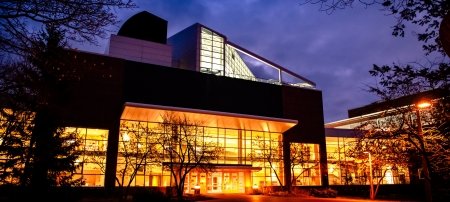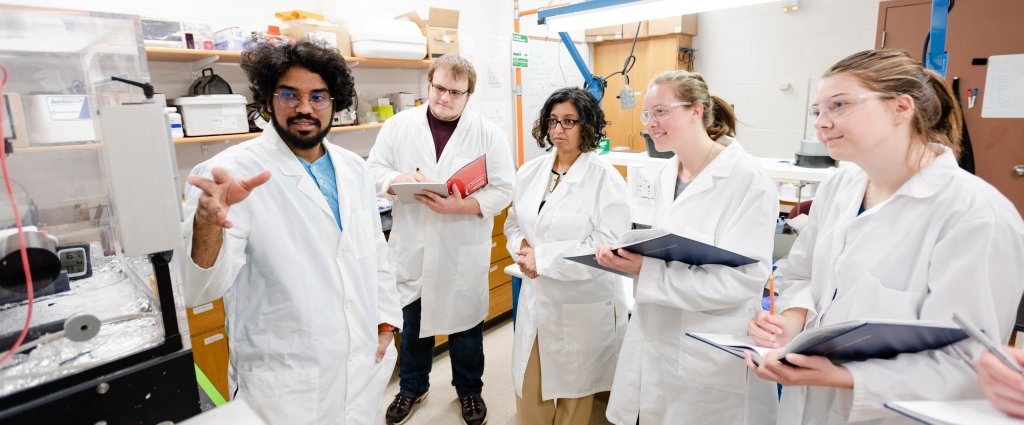Geology Grad Student Helps Indonesians Understand Their Volcanoes

Nine thousand miles is a long way to go for research. But, if you are studying volcanoes, Indonesia is the place to be.
For Peace Corps Master’s International (PCMI) student Jay Wellik, it became even more than a place to study volcanoes. It became home, as he worked in Java, mostly near the Raung volcano.
As the first Michigan Technological University student to work in Indonesia, Wellik endeared himself to the local governments and people, for his risk perception and mitigation, as well as for his willingness to jump into community life.
He researched two relatively active volcanoes, Raung and Ijen, working from observatory posts there, while also teaching English and coaching basketball in a “madrasah,” a state Islamic school. Wellik says he appreciates the different perspective he gained from the classroom and basketball courts.
He explains his research. “Raung has produced small eruptions every three to five years for the last thirty years, and Ijen is constantly producing sulfur plumes under and near its crater lake,” he says. “A lot of the monitoring equipment at each of these volcanoes, however, is new.”
Thus, knowledge of each volcano's eruptive cycle is limited, he says. At Ijen, where daily visual observations from sulfur miners and tourists can corroborate the paper seismic record, older observers have an intuitive sense of the volcano’s behavior. At Raung, however, where the active vent is two hundred to five hundred meters below a crater rim—a ten-hour hike—it is less understood.
Over the last two years, Wellik helped the US Geological Survey and PVMBG (Indonesia's Center for Volcanology and Geologic Hazard Mitigation) install two new permanent instruments on opposite flanks of Raung. “This new instrumentation was the primary cause for the concern that was felt when seismic activity increased at Raung last year,” he says. “We knew that Raung had a historical context of frequent but small eruptions, but this was the first time that activity had ever produced a seismic signal.”
Wellik says it was unclear whether or not the signals were being caused by the normal cycle of eruptive behavior and simply recorded for the first time, or if the magnitude of activity really was larger than anything that had been seen in recent history. “Prudence led PVMBG to assume the worst, and they enacted many measures from their crisis-response routine,” he says.
“During that response, I helped install two temporary seismometers and interpret the data as it came in. Ultimately, it became clear that the strombolian [low-level] activity fit Raung's usual trend and was probably smaller than previous episodes,” he adds. “Because this is Raung's first eruption to be recorded in so much detail, it's important to understand the stages in the eruptive cycle and how they are manifested in Raung's seismic signal.”
Wellik says his primary role was training observatory staff, including a background education in geology and volcanology, seismic data software, and, most importantly, geographic information systems (GIS) software.
“The GIS will allow them to be more directly involved in planning their seismic network as it expands,” he says. “GIS can be used to determine which areas of the mountain have direct radio communication back to the post, the first step to installing a seismometer. I went into the field last week with observatory staff, and they brought along a topographic map that they made themselves. The staff now has the ability to make these maps for public display, and they can show the seismic network, trails or exclusion zones.”
Wellik hopes that this work behind the scenes makes efforts during eruptive periods easier and more effective.
Observatory Post as Local Hangout
His observatory post also became the locus of not just equipment, but also communication with local residents, the volcanologist says.
“The first role of an observatory includes maintaining equipment, recording observations and making basic interpretations,” he explains. “The second role is to act as an interface between the scientists and the public. The Raung post is at the end of a long road, out-of-sight to the community. The only people to pass by daily were the people who worked in the surrounding clove plantations and cane fields.”
That was about to change.
“The swarm of visitors started when activity increased at the volcano,” Wellik says. “The warning level raised from Normal to Watch to Stand-by, and all of a sudden, everyone in the community was interested in the observatory. Some people wanted to ask the staff about the current activity and potential hazards. Others wanted to look at the maps of the volcano and the charts depicting rising activity levels that we had taped to the windows. The biggest attraction was the paper heliocorder itself. People would sit at the window and watch the drum spin and scribble out the seismic signal for hours at a time. It enthralled everyone.”
The post became so popular that people were showing up just to hang out. A woman set up a fruit stall in the driveway, and a man was peddling bakso (Indonesian meatballs) near the building.
PVMBG deliberately intends for the observatory posts to be centers of public outreach, Wellik points out. There are more than 70 active volcanoes in Indonesia, and many of them are near densely populated areas. PVMBG needs each post to be a respected, and trusted entity in the community. “A member of the USGS Volcano Disaster Assistance Program (VDAP) who has worked at volcanoes all over the world believes that no country manages public outreach better than Indonesia,” Welik says.
Wellik saw more payoffs for this type of interaction. First, they dispelled many rumors and myths. As people asked questions, the staffers were able to correct misconceptions about how volcanoes work, what had already happened at Raung during this spate of activity and what they could expect to happen at Raung in the future. People also were able to see the whole process for themselves. They could watch the paper heliocorders get written in real time, and they could peruse the graphics about the volcano.
Even high-level meetings were transparent.
“When there were meetings between PVMBG officials, community leaders and the military, people could watch through glass doors and then directly receive the message afterwards,” Wellik says. “I think this built a real trust and respect between PVMBG's officials and the public.”
“The primary lesson I've received from this experience is just how involved the entire process of volcano monitoring is. Monitoring volcanoes to a level that is useful to saving lives is about much more than seismology and data interpretation. I sensed that this was true before I joined Peace Corps, but the last two years have allowed me to see it first hand.”
Back on campus, Wellik is working on his master’s thesis with data from Raung and Ijen as well as signals from Mount St. Helens.
“The goal of the project is to create software tools to help observatories better calculate the total energy release from volcanic earthquakes, even if the seismic network and resulting signal are poor," he says. "This should be useful at poorly monitored volcanoes around Indonesia and other parts of the world.”
Michigan Technological University is a public research university founded in 1885 in Houghton, Michigan, and is home to more than 7,000 students from 55 countries around the world. Consistently ranked among the best universities in the country for return on investment, Michigan’s flagship technological university offers more than 120 undergraduate and graduate degree programs in science and technology, engineering, computing, forestry, business and economics, health professions, humanities, mathematics, social sciences, and the arts. The rural campus is situated just miles from Lake Superior in Michigan's Upper Peninsula, offering year-round opportunities for outdoor adventure.




Comments